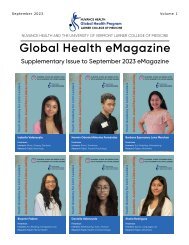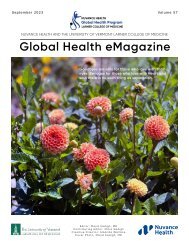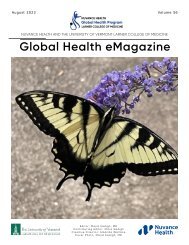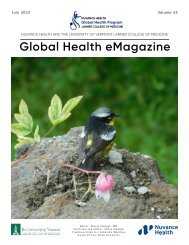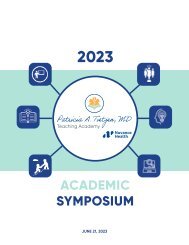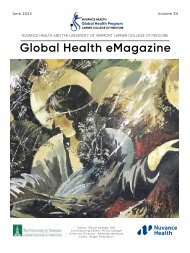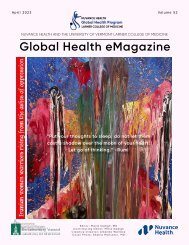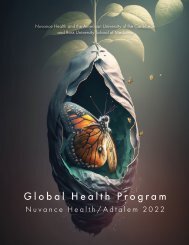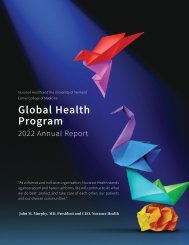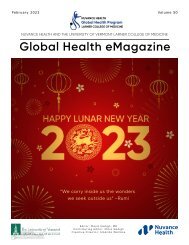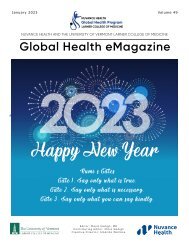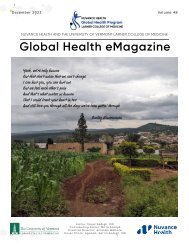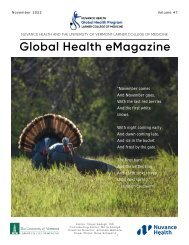eMagazine March 2023
You also want an ePaper? Increase the reach of your titles
YUMPU automatically turns print PDFs into web optimized ePapers that Google loves.
OUR PEOPLE,<br />
OUR MISSION<br />
Reflections<br />
Global Health<br />
<strong>eMagazine</strong><br />
<strong>March</strong> <strong>2023</strong><br />
Highlights<br />
Reviews<br />
GH Narrative<br />
Reflections<br />
Hispanic and Latinx Voices<br />
Global Local<br />
Voices of Ugandan<br />
Students<br />
Nursing Division<br />
Women’s Health Education<br />
Innovation and Technology<br />
Our Beautiful Planet<br />
Art to Remind Us of Who We<br />
Can Be<br />
Article of the Month<br />
You’re Invited<br />
Photo News<br />
Calendar<br />
Global Health Family<br />
Resources<br />
Previous Issues of<br />
the <strong>eMagazine</strong><br />
Butterflies<br />
Written by Keara Lynn<br />
MD Candidate, Class of <strong>2023</strong><br />
The Robert Larner College of Medicine at the<br />
University of Vermont<br />
No matter how much reading and mental<br />
preparation you do before starting a global<br />
health elective, there are, unsurprisingly perhaps,<br />
some things you can’t prepare for. After only two<br />
days on the wards at Parirenyatwa Hospital in Harare, there have been many<br />
times where I have thought to myself “If we just had XYZ, this would be easier.” For<br />
a woman who had recently given birth with tachycardia and shortness of breath;<br />
“If we just had CTA, we could quickly rule out PE.” For a woman presenting with<br />
left hemiparesis and hypertensive emergency; “If we had emergent CT we could<br />
differentiate hemorrhagic vs ischemic.” For a man who was seen for mysterious<br />
symptoms in KS clinic who had been feeling ill for so long that he told us “I just<br />
want to stay at home and die” but who could not afford the histopathology for<br />
a skin punch biopsy; “how much does histopathology cost anyway and is there<br />
no way to get this test covered?”<br />
Our first night on call, we were a bit surprised to see a consultant with a Butterfly<br />
portable ultrasound. We gravitated to the patient’s bedside to watch the scan.<br />
“You have these at home?” the consultant asked. We confirmed that we use<br />
Butterfly quite a bit at home. “Well maybe you can bring us some more the next<br />
time you come?” Whether this was said in jest or in seriousness, it was difficult<br />
to tell. Either way, at that point I had butterflies in my stomach. Could we bring<br />
Butterfly units with us the next time students rotate here? Should we have brought<br />
something with us this time?<br />
I know for a fact that there are approximately 10 Butterfly kits in the UVM Dana<br />
Library available to students at any given time. I know this because I have<br />
checked one out twice now myself. For a month at a time, I was able to bring the<br />
kit home and practice scanning my friends. But other than the two hours I spent<br />
scanning over the course of the month, the Butterfly sat neatly packed away<br />
in its bag in my apartment. A perfectly useful tool, essential to diagnosis and<br />
management decisions, totally portable, totally functional, just sitting around.<br />
Some of the University of Zimbabwe medical students on our team wandered<br />
over to the patient’s bedside to see what was going on. One of the students<br />
mentioned she had not used a portable ultrasound machine before. The<br />
butterflies in my stomach were guilt and also sadness. Does UVM really need 10<br />
butterfly kits sitting in the library? There is never a waiting list to take one out.<br />
Could we get away with five or three kits instead? Can we justify this excess in<br />
the name of medical education?<br />
Reflections continued on next page >><br />
16




